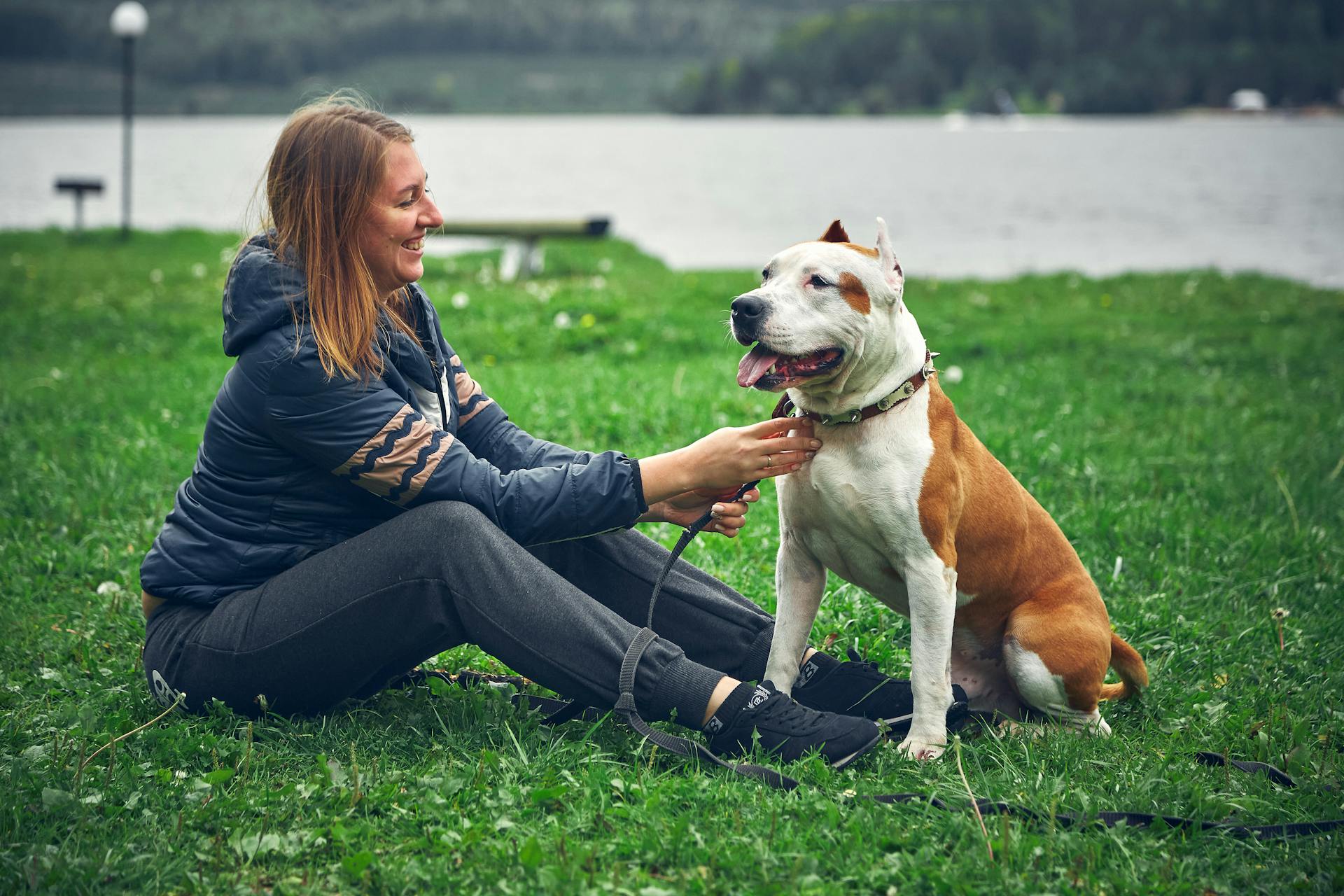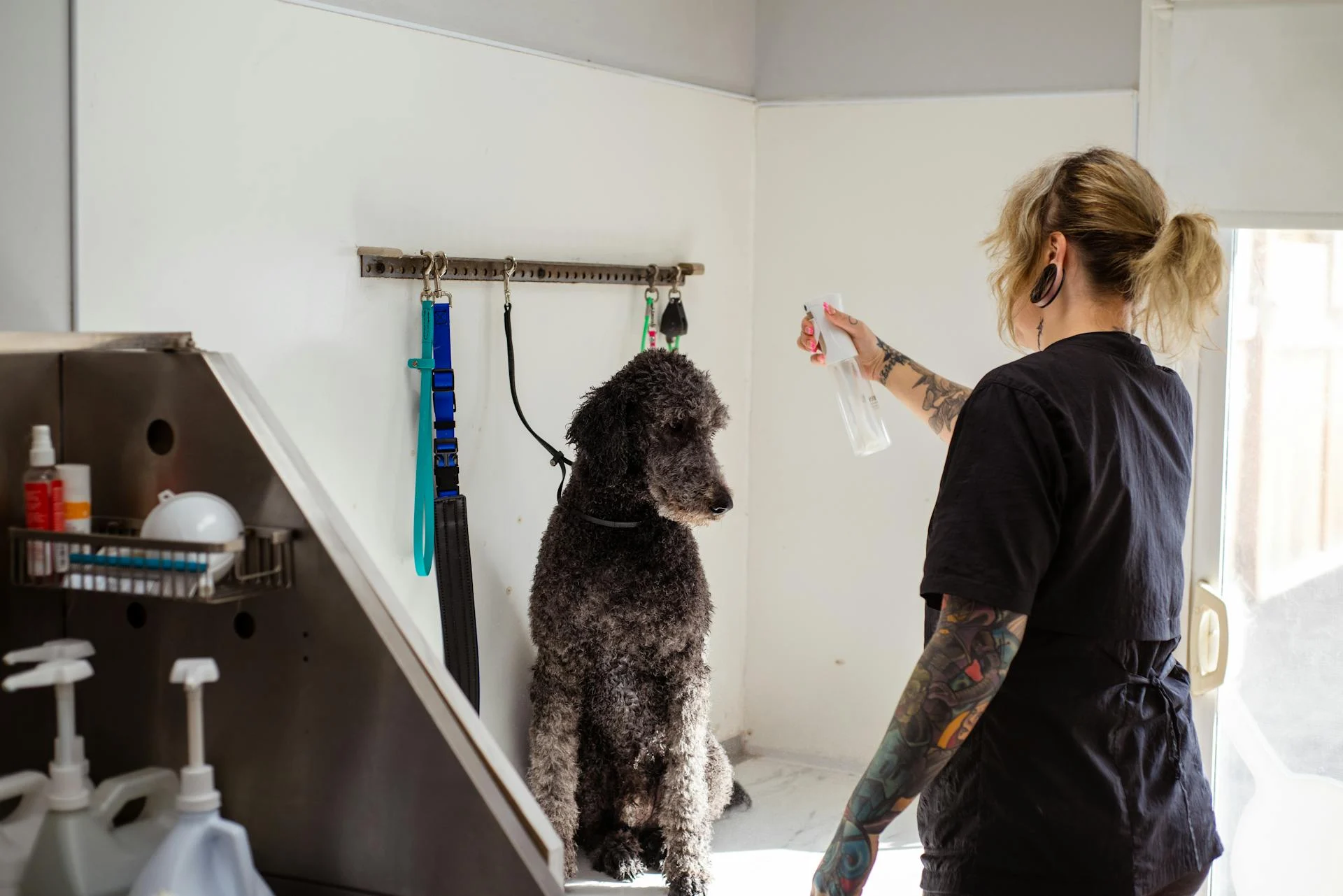
The Staffordshire Bull Terrier is a beloved breed known for its friendly and outgoing personality. They are a relatively small dog, weighing between 24-38 pounds and standing between 14-16 inches tall.
Staffordshire Bull Terriers are prone to certain health issues, including hip dysplasia and eye problems. Regular veterinary check-ups can help identify these issues early on.
With proper care, Staffordshire Bull Terriers can live a long and healthy life, typically between 12-14 years.
Curious to learn more? Check out: What Are the 14 Ancient Dog Breeds
What Is a Staffordshire Bull Terrier?
The Staffordshire Bull Terrier is a breed of dog that originated in the United Kingdom, specifically in the county of Staffordshire.
They were originally bred in the 19th century as a fighting dog, but over time, their purpose shifted to companionship and family pets.
The breed is known for its muscular build and short, easy-to-maintain coat.
Staffordshire Bull Terriers typically weigh between 24 and 38 pounds and stand between 14 and 16 inches tall at the shoulder.
Their friendly and outgoing personalities make them a popular choice for families with children, and their loyalty to their owners is unwavering.
Personality
Staffordshire Bull Terriers are known for their gentle, playful temperament.
They love their family, especially children, and have even been nicknamed the "Nanny Dog" because of their devotion to them.
This breed is very energetic and enthusiastic in everything they do, always remaining on alert, even in repose.
Staffies are people-loving, making them a good caretaker of their family, but they're less likely to be protective of property.
They'll always alert you to the presence of visitors, wanted or unwanted.
Early socialization is crucial for this breed, exposing them to many different people, sights, sounds, and experiences when they're young.
This helps ensure that your Stafford puppy grows into a well-rounded dog.
Enrolling them in a puppy kindergarten class is a great start to their socialization journey.
Inviting visitors over regularly, taking them to busy parks, and taking them on leisurely strolls to meet neighbors will also help them polish their social skills.
While Staffies can be aggressive toward other dogs and animals, they are generally friendly toward strangers when responsibly trained and socialized.
However, they can be overly exuberant and rough due to their strength, making them not ideal for older adults or young children.
They learn easily and like to please, but can be stubborn and might resist when told to do something they disagree with.
A different take: What Age Can You Breed Male Dogs
Care and Feeding
To keep your Staffordshire Bull Terrier in top shape, it's essential to feed them the right amount of high-quality dog food. Recommended daily amount is 1 5/8 to 2 1/4 cups, divided into two meals.
Feeding them twice a day rather than leaving food out all the time is a great way to ensure they're getting the right amount of nutrients. You should be able to see a waist when looking down at them, and you should be able to feel but not see their ribs without pressing hard.
A highly active dog will need more food than a couch potato dog, so keep an eye on their activity level and adjust their food intake accordingly.
Curious to learn more? Check out: Shiba Inu Coin 1 Cents
Feeding

Feeding your Staffordshire Bull Terrier (SBT) is an essential part of their care. Provide 1 5/8 to 2 1/4 cups of high-quality dog food daily, divided into two meals.
The amount of food your SBT needs depends on their size, age, build, metabolism, and activity level. Highly active dogs require more food than couch potato dogs.
Withhold food and water for at least an hour after vigorous exercise to avoid gastric dilatation volvulus, also known as bloat. This is a serious health issue that requires immediate attention.
Measuring your SBT's food and feeding them twice a day rather than leaving food out is crucial for maintaining their shape. This helps prevent overeating and ensures they get the right amount of nutrients.
Check your SBT's weight by giving them the eye and hands-on tests. Look down at them and see if you can spot a waist – if not, they might be overweight.
See what others are reading: How Much to Feed Bernese Mountain Dog Puppy
Care
Caring for your new pet is a big responsibility, but it's also super rewarding.

Make sure to provide fresh water at all times, as mentioned in the "Hydration" section, where it's stated that a general rule of thumb is to change the water at least twice a day.
Creating a routine is key to keeping your pet happy and healthy.
This includes regular feeding times, as outlined in the "Nutrition" section, where it's recommended to feed your pet at the same times every day to establish a routine.
Establishing a safe and comfortable environment is crucial for your pet's well-being.
This includes providing a clean and quiet space to rest, as mentioned in the "Sleep" section, where it's noted that pets need 12-16 hours of sleep per day.
Regular grooming is essential for your pet's physical and mental health.
This includes brushing their fur regularly, as mentioned in the "Grooming" section, where it's recommended to brush your pet's fur at least once a week to prevent matting and tangling.
You might enjoy: National Boston Terrier Day
Health and Grooming
The Staffordshire Bull Terrier's grooming needs are relatively low-maintenance, thanks to their short, smooth coat.
Their coat sheds annually, but hair loss is minimal throughout the year. Dirt brushes out easily, and the coat dries quickly after a bath.
Brush your Staffordshire Bull Terrier weekly to remove dead or loose hair, and bathe as needed – they have little odor, so frequent bathing is not required.
Health
Taking care of your health is crucial for overall well-being. Regular exercise can help reduce the risk of chronic diseases, such as heart disease and diabetes.
Proper nutrition is essential for maintaining a healthy body. Eating a balanced diet that includes plenty of fruits and vegetables can help support immune function.
Adequate sleep is vital for physical and mental restoration. Most adults need 7-9 hours of sleep per night to feel rested and alert.
Stress management is essential for maintaining mental health. Engaging in activities that bring joy and relaxation, such as reading or meditation, can help reduce stress levels.
Regular check-ups with a healthcare provider can help identify potential health issues early on. This can lead to more effective treatment and better health outcomes.
Coat Color and Grooming
The Staffordshire Bull Terrier's coat is a breeze to maintain, with a short, smooth coat that lies close to the skin. This makes it easy to remove dead hair and distribute natural oils.
The breed comes in a variety of colors, including red, fawn, white, black, or blue, and any combination of these colors with white or brindle. You'll also find brindle with white.
Dirt brushes out easily, and the coat dries quickly after a bath. This means you don't need to bathe your Staffordshire Bull Terrier frequently, as they have little odor. Brush your Staffordshire Bull Terrier weekly to remove dead or loose hair, and bathe them as needed.
Other grooming needs include dental hygiene and nail care. Brush your Stafford's teeth at least two or three times weekly to remove tartar buildup and bacteria. Daily brushing is even better.
Trim their nails once or twice a month, or as needed, to keep them short. You'll know they're too long if you can hear them clicking on the floor.
Frequently Asked Questions
Is a Staffordshire Bull Terrier the same as a pitbull?
The Staffordshire Bull Terrier is a breed that falls under the broader term "Pit Bull," but it's a distinct breed with its own characteristics. While related, the two are not exactly the same, and understanding their differences is key to appreciating these unique dogs.
Are staffordshire bull terriers good pets?
Staffordshire bull terriers are affectionate and loving family pets, known for forming strong bonds with their families. They make great companions, but require a secure living space due to their jumping ability.
What two dogs make a Staffordshire Bull Terrier?
Staffordshire Bull Terriers are a result of breeding bull and terrier crosses, which over time evolved into two distinct breeds: the Staffordshire Bull Terrier and the Bull Terrier.
Featured Images: pexels.com


